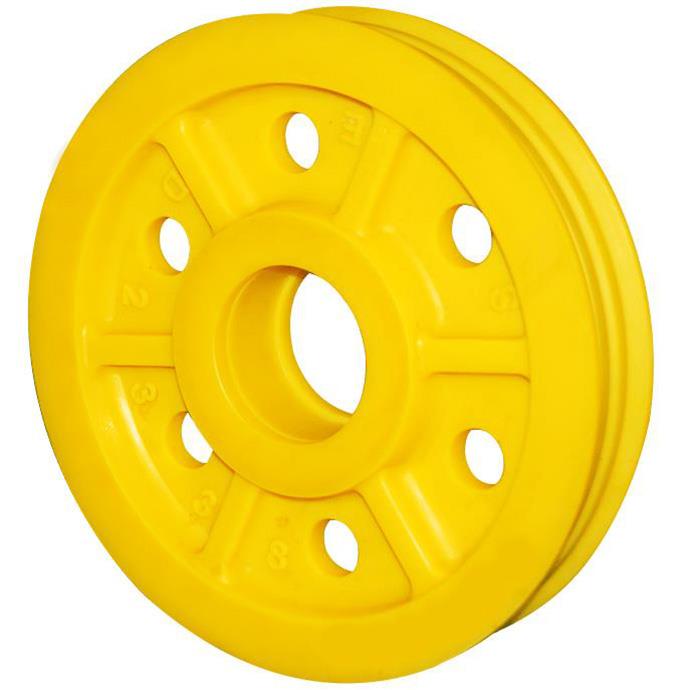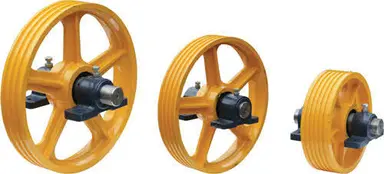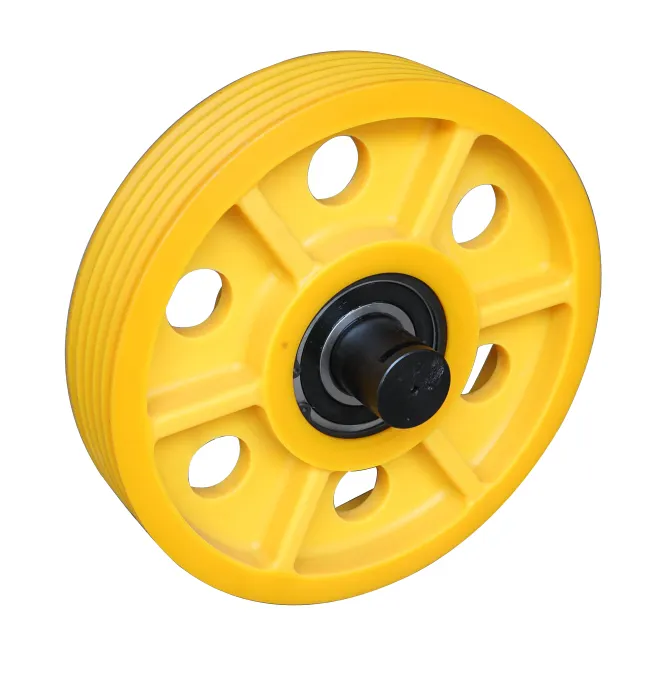Product Description
3 Ton Cable Pulling Pulley Hoisting Lifting Block Wire Rope Pulley Hook Type Lifting Pulley Block and Tackle Pulley
This aluminum alloy and MC nylon open type hoisting tackle with hook possesses light dead weight, which is equipped with the aluminum alloy side panel and the MC nylon sheave. This single Sheave Pulley block is the open type. Our product can be used for lifting heavy objects and other operations in the line construction.
Uses: Applied in line construction for lifting weight.
Features: Adopt aluminum alloy side panel and MC nylon sheave.so it is light in weight.the single sheave hoisting tackle is open style.
Main Specifications
| Item Number | Model | Number of Sheave | Rated Load (kN) | Outer Diameter of Sheave ×Sheave Width (mm) | Rope Diameter (mm) | Weight (kg) | Hoisting Point Type | ||
| 11101 | QHN1-1K | 1 | 10 | Φ100×31 | Φ7.7 | 1.8 | G | H | |
| 11102 | QHN1-2 | 2 | 10 | Φ80×27 | Φ6 | 1.8 | G | H | |
| 11103 | QHN1-3 | 3 | 10 | Φ80×27 | Φ6 | 2.1 | G | H | |
| 11111 | QHN2-1K | 1 | 20 | Φ120×35 | Φ9.3 | 2.2 | G | H | B |
| 11112 | QHN2-2 | 2 | 20 | Φ100×31 | Φ7.7 | 2.6 | G | H | |
| 11113 | QHN2-3 | 3 | 20 | Φ100×31 | Φ7.7 | 3.7 | G | H | |
| 11121 | QHN3-1K | 1 | 30 | Φ150×39 | Φ11 | 3.4 | G | H | B |
| 11122 | QHN3-2 | 2 | 30 | Φ120×35 | Φ9.3 | 4.5 | G | H | |
| 11123 | QHN3-3 | 3 | 30 | Φ100×31 | Φ7.7 | 4.6 | G | H | |
| 11131 | QHN5-1K | 1 | 50 | Φ166×40 | Φ13 | 5.2 | G | H | B |
| 11133 | QHN5-2 | 2 | 50 | Φ150×39 | Φ11 | 5.5 | G | H | |
| 11134 | QHN5-3 | 3 | 50 | Φ120×35 | Φ9.3 | 5.1 | G | H | |
| 11141 | QHN8-1K | 1 | 80 | Φ205×49 | Φ17 | 7.2 | G | H | B |
| 11142 | QHN8-2 | 2 | 80 | Φ166×40 | Φ13 | 8.3 | G | H | |
| 11143 | QHN8-3 | 3 | 80 | Φ150×39 | Φ11 | 7.9 | G | H | |
| 11151 | QHN10-1K | 1 | 100 | Φ246×60 | Φ18.5 | 11.4 | G | B | |
| 11152 | QHN10-2 | 2 | 100 | Φ166×40 | Φ13 | 10.2 | H | ||
| 11153 | QHN10-3 | 3 | 100 | Φ150×39 | Φ11 | 11.7 | H | ||
| 11161 | QHN15-1K | 1 | 150 | Φ280×65 | Φ21.5 | 12.1 | B | ||
| 11162 | QHN15-2 | 2 | 150 | Φ205×49 | Φ17 | 12.8 | H | ||
| 11163 | QHN15-3 | 3 | 150 | Φ166×40 | Φ13 | 11.8 | H | ||
| 11164 | QHN15-4 | 4 | 150 | Φ150×39 | Φ11 | 13.9 | H | ||
To support the Transmission work, CHINAMFG Power has Tubular Gin Pole, Hydraulic cable puller, wire rope pulley block, hoisting tackle, Wire rope gripper , Cable reel spool and stand- all are OEM and professionally produced per ISO 9001:2008, which are being sold to over more than 50 countries in the world. Some items like emergency restoration tower and crossing structure, we can customized, and the safety tools and accessories, are not demanded the MOQ. You can freely help you out either Tech issue or Products requirements. Pls contact us. Thanks.
1. Training and services.
Marshine is a company specializing in the development, design and manufacture of electrical construction equipment and tools. We not only manufacture and sell international standard products, OEM and custom products, but also provide quality tracking and service monitoring.
2. How about the quality of your products?
Our products are manufactured in strict accordance with national and international standards, and each product is tested before delivery. If you would like to view our quality certification and various test reports, please consult us.
3. Why do you choose us?
Because we can provide you with excellent service, quality and reasonable price. In addition, we can also provide smooth delivery of goods, excellent customer solutions.
4. Customer inquiry.
If there is an emergency, customers can also use online contact methods (online Chat, Skype, WhatsApp, ) for faster and better communication. Any enquiry will be answered within 12 working hours.
5. How to obtain samples?
We can provide free samples to the buyer for testing, but the buyer needs to pay the freight. Existing samples take 2-3 days. If there is no stock, we will advise the delivery date.
6. How about packing and shipping?
All goods will be packed in plywood boxes for safe, long haul transport. Support EXW, FOB, CIF, CFR terms.
Required documents such as packing list, commercial invoice, bill of lading, air waybill, CO, Form E, Form F etc will be provided.
Note: If you do not find the product you need, please feel free to contact us. We will provide the best quotation as soon as we verify your requirements.
| After-sales Service: | 1 Year |
|---|---|
| Warranty: | 1 Year |
| Type: | Hook |
.shipping-cost-tm .tm-status-off{background: none;padding:0;color: #1470cc}
|
Shipping Cost:
Estimated freight per unit. |
about shipping cost and estimated delivery time. |
|---|
| Payment Method: |
|
|---|---|
|
Initial Payment Full Payment |
| Currency: | US$ |
|---|
| Return&refunds: | You can apply for a refund up to 30 days after receipt of the products. |
|---|
Can lifting pulleys be upgraded or retrofitted into existing lifting systems?
Yes, lifting pulleys can be upgraded or retrofitted into existing lifting systems to improve their performance, efficiency, and safety. Upgrading or retrofitting lifting pulleys offers several benefits and allows for the integration of new technology and advancements. Here’s a closer look at the process and advantages:
1. Assessment of Existing System: Before considering an upgrade or retrofit, it is important to assess the existing lifting system. Evaluate the condition of the pulleys, cables, ropes, and other components. Determine if any components are outdated, worn, or no longer meet the requirements of the lifting operation.
2. Identifying Improvement Opportunities: Identify the areas where the lifting system can be improved. This can include enhancing load capacity, increasing efficiency, improving load control, reducing maintenance requirements, or enhancing safety features.
3. Consulting with Experts: Seek advice from lifting equipment specialists or engineers who have expertise in upgrading or retrofitting lifting systems. They can provide valuable insights and recommendations based on their knowledge and experience.
4. Selection of Upgraded Pulleys: Select lifting pulleys that align with the specific requirements and improvement goals of the existing lifting system. Consider factors such as load capacity, efficiency, load control features, durability, and compatibility with the existing system.
5. Installation and Integration: Install the upgraded pulleys into the existing lifting system. Ensure that the installation is carried out by qualified personnel following the manufacturer’s guidelines and safety procedures. Integrate the new pulleys seamlessly with the existing components, such as cables, ropes, and attachments.
6. Testing and Performance Evaluation: Conduct thorough testing and performance evaluation of the upgraded lifting system. Verify that the new pulleys meet the desired improvements in terms of load capacity, efficiency, load control, and safety. Address any issues or adjustments that may arise during the testing phase.
7. Training and Familiarization: Provide training to operators and maintenance personnel on the proper usage, maintenance, and safety precautions related to the upgraded lifting pulleys. Ensure that they are familiar with any new features or functionalities introduced by the upgrade.
8. Maintenance and Regular Inspection: Establish a maintenance schedule for the upgraded lifting pulleys and associated components. Regularly inspect and maintain the pulleys to ensure their optimal performance and longevity. Follow the manufacturer’s recommended maintenance procedures.
By upgrading or retrofitting lifting pulleys into existing lifting systems, organizations can leverage the benefits of modern technology and advancements without the need for a complete system overhaul. This approach enhances the efficiency, performance, and safety of the lifting operations, ultimately improving productivity and extending the lifespan of the lifting system.
How do lifting pulleys enhance the safety and efficiency of lifting operations?
Lifting pulleys play a vital role in enhancing the safety and efficiency of lifting operations. They provide several advantages that contribute to safe and efficient lifting. Here’s how lifting pulleys enhance safety and efficiency:
1. Mechanical Advantage: Lifting pulleys provide a mechanical advantage by distributing the load’s weight across multiple sheaves or blocks. This distribution reduces the amount of force required to lift the load, making it easier for operators to handle heavy objects. The mechanical advantage offered by lifting pulleys minimizes the risk of strain or fatigue-related injuries to operators, promoting safe lifting practices.
2. Load Distribution: By utilizing lifting pulleys, the load’s weight is distributed among multiple strands of lifting cables or ropes. This distribution helps to evenly spread the load’s force, reducing the risk of overload on any single point or component. Load distribution minimizes the chances of cable or rope failure, ensuring safe lifting and preventing accidents due to sudden load shifts or unbalanced loads.
3. Controlled Movement: Lifting pulleys enable precise and controlled movement of the load. The pulleys allow operators to adjust the lifting speed, direction, and position of the load with ease. This control enhances safety by preventing sudden or jarring movements that can lead to accidents or damage to the lifted objects. It also allows for accurate placement or positioning of the load, improving operational efficiency.
4. Reduced Friction: Lifting pulleys are designed to reduce friction between the lifting cables or ropes and the pulley sheaves. This reduction in friction minimizes wear and tear on the lifting components, such as cables or ropes, extending their lifespan and reducing the risk of failure during lifting operations. It also reduces the effort required to lift the load, improving efficiency and operator comfort.
5. Versatility and Adaptability: Lifting pulleys offer versatility and adaptability in various lifting scenarios. They can be combined with other pulleys or lifting systems to create compound mechanical advantages, such as block and tackle systems. This flexibility allows operators to handle different load capacities and adapt to specific lifting requirements. Versatility and adaptability enhance the efficiency of lifting operations by providing suitable solutions for a wide range of lifting tasks.
6. Safe Working Load Indication: Many lifting pulleys come with clearly marked safe working load (SWL) indications. These markings provide crucial information about the maximum load capacity that the pulley can safely handle. By adhering to the SWL guidelines, operators can ensure that the pulleys are not overloaded, reducing the risk of accidents and equipment failures.
7. Training and Operator Awareness: Proper training and operator awareness regarding the use of lifting pulleys contribute to safe and efficient lifting operations. Operators should receive training on the correct techniques for operating and maintaining lifting pulleys. They should also be aware of safety protocols, load limits, and the importance of regular inspections and maintenance procedures. Well-trained operators can make informed decisions, identify potential hazards, and implement safe work practices, further enhancing the safety and efficiency of lifting operations.
By utilizing lifting pulleys, operators can benefit from improved safety and efficiency in lifting operations. The mechanical advantage, load distribution, controlled movement, reduced friction, versatility, and operator training all contribute to safer lifting practices, reduced risk of accidents, and increased operational efficiency.
What role do lifting pulleys play in supporting and guiding lifting cables or ropes?
Lifting pulleys play a crucial role in supporting and guiding lifting cables or ropes during lifting operations. They serve several important functions that contribute to the safe and efficient movement of loads. Here are the key roles that lifting pulleys play:
1. Load Support: Lifting pulleys provide a stable and secure platform for supporting the weight of the load. The load is typically attached to the lifting cable or rope, which passes through the pulley. The pulley’s design, construction, and load-bearing capacity ensure that it can safely support the weight of the load without deformation or failure.
2. Force Distribution: Lifting pulleys distribute the force applied to the lifting cable or rope evenly across the pulley wheel. As the cable or rope passes over the pulley, the load’s weight is distributed over a larger area, reducing stress and preventing excessive wear on the cable or rope. This force distribution helps to maintain the integrity and longevity of the lifting medium.
3. Friction Reduction: Lifting pulleys are designed to reduce friction between the lifting cable or rope and the pulley wheel. They often feature smooth surfaces, rounded grooves, or ball bearings that minimize the contact area and frictional forces. By reducing friction, the pulleys enable smoother movement of the lifting medium, reducing wear on the cable or rope and facilitating more efficient lifting.
4. Directional Guidance: Lifting pulleys guide the lifting cable or rope along a specific path, ensuring that it stays aligned and properly positioned during the lifting process. The pulleys prevent the cable or rope from twisting, tangling, or deviating from the intended path, which could compromise the safety and effectiveness of the lifting operation.
5. Tension Control: Lifting pulleys assist in controlling the tension in the lifting cable or rope. By adjusting the position and angle of the pulley, operators can regulate the tension applied to the lifting medium. This control over tension is crucial for maintaining stability, preventing slippage, and ensuring safe and controlled lifting of the load.
6. Force Amplification: Lifting pulleys amplify the force applied to the lifting cable or rope. By using multiple sheaves or wheels, the pulleys increase the mechanical advantage, allowing operators to lift heavier loads with reduced effort. This force amplification is particularly beneficial when dealing with heavy loads that would require excessive force to lift without the mechanical advantage provided by the pulleys.
Overall, lifting pulleys play a vital role in supporting and guiding lifting cables or ropes. They provide load support, distribute forces evenly, reduce friction, guide the lifting medium along the desired path, assist in tension control, and amplify the applied force. These functions contribute to the safe, controlled, and efficient movement of loads during lifting operations.
editor by CX
2023-11-17




